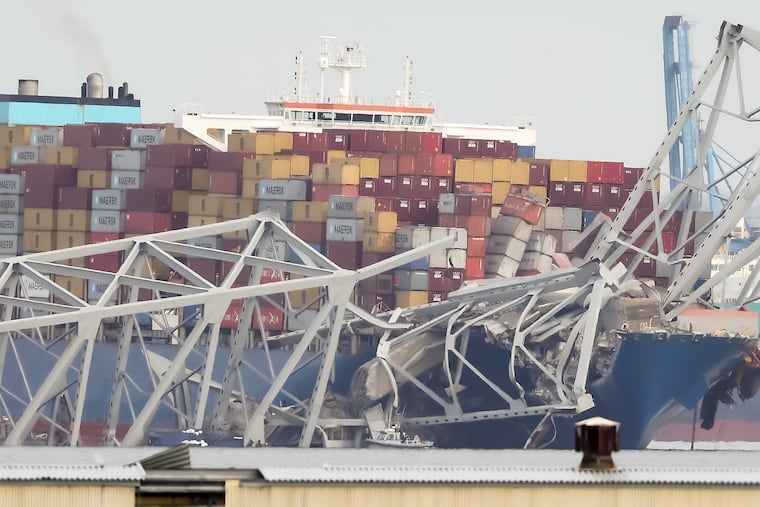Philly-area port authority plans to review bridge safety features in the wake of Baltimore bridge collapse
Delaware Bridges have robust protections from ship collisions, as investigators focus on causes of the Baltimore bridge collapse.

The National Transportation Safety Board says a critical question in the investigation of Tuesday’s collapse of the Francis Scott Key bridge in Baltimore is whether the structure had adequate buffers to absorb the force of the massive container ship that slammed into one of its pillars.
In the Philadelphia area, the Delaware River Port Authority says that each of its four bistate bridges has features to shield the piers, which are reinforced concrete pillars that extend into the water and support the superstructure of a bridge while distributing loads to the footings anchored in the riverbed.
“Our bridges are very safe, considering the type of shipping channel we’re in and the protections we have in place,” John T. Hanson, the agency’s CEO, said.
The Betsy Ross Bridge, like Baltimore’s Key, is a continuous truss bridge but there are differences. First, the shipping channel is much less busy at that point on the Delaware River than at the mouth of Baltimore Harbor. And the ships that travel there are smaller.
And the Betsy is protected by “dolphins,” massive reinforced concrete cylinders that protrude above the water line and are meant to stop ships in the channel from hitting one of the piers holding up the bridge, Hanson said.
On Wednesday, Hanson said he directed the Port Authority’s chief engineer to expedite a planned review of safety features on the Commodore Barry Bridge in the wake of the Baltimore catastrophe.
DRPA built artificial islands of rocks around the piers of the bridge in 2008. “It is the closest to the open water of the Delaware Bay, but a ship would run aground before it hit the pier,” Hanson said. He said engineers will study whether more protection is needed and recommend options if so.
The Walt Whitman and Benjamin Franklin are steel suspension bridges and have fenders made of timbers around the base of the piers. Hanson said they are in relatively shallow water with narrower navigation channels than the other two DRPA spans.
“It’s relatively hard for big ships to get near those bridges, and many that do go up that far are using tugboats,” Hanson said. “You design for the type of threat you are going to face.”
Still, a review to determine whether the Ben Franklin and Walt Whitman Bridges need updated protection has been underway since before the Baltimore crash, he said. “We’re not complacent.”
Baltimore collapse under investigation
It’s unclear from video footage of the Key Bridge crumpling into the water at 1:30 a.m. Tuesday whether any substantial features were protecting the bridge pier that was hit by a 95,000-ton cargo ship that had lost power, collapsing the entire span.
The Singapore-flagged Dali had Baltimore Harbor pilots on board guiding the ship, but no tugboats were alongside as it approached the bridge, authorities said. A mayday call was broadcast just before impact, enabling police to block traffic from crossing the bridge. Six construction workers who were fixing potholes are presumed dead. Two of their bodies were recovered on Wednesday.
Jennifer Homendy, chair of the NTSB, told reporters during a news conference that her teams would be looking closely at the piers.
“There’s some questions about the structure of the bridge — protective structure around the bridge or around the piers to make sure there isn’t a collapse,” she said.
Some engineering experts said such a structure might have diverted the ship away from a direct hit on the pier. Others said that little could stop a freighter as massive as the Dali; container ships have grown larger in recent decades.
Transportation Secretary Pete Buttigieg expressed the latter view. “This is a unique circumstance. I do not know of a bridge that has been constructed to withstand a direct impact from a vessel of this size,” he said.